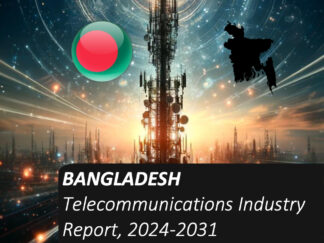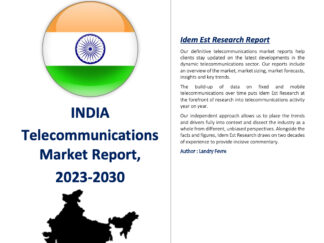Your cart is currently empty!
Australia Telecoms Industry Report – 2025-2032
This report provides analyses of revenue and market forecasts as well as statistics of the Australian telecoms industry including market sizing, 5-year forecasts, market insights, key telecom trends, 5G, digital infrastructure and also features the following: Overall Telecommunications Market by Major Operators Telco Operators Profile, Revenue and EBITDA Mix Mobile Subscribers & Revenue Market Overview and Forecasts Spectrum Holdings IoT Market Overview Broadband Subscribers & Revenue Market Overview and Forecasts Digital Infrastructure (Fibre, Telecom Towers, Data Centres, Submarine Cables) National Broadband Network Detailed Market Overview and Forecasts Telecom Tower Market Analysis and Forecast Thematics / Opportunities relating to 5G, M&A…
Description
WHY YOU SHOULD BUY THE AUSTRALIA TELECOMS INDUSTRY REPORT:
- Benefit from the latest market opportunities
- Understand the threats to your operations and investments and protect your company against future risks
- Gain insight on emerging trends that could support, strengthen or disrupt your activities in the market
- Get a full view of the competitive landscape to assess your market position.
- Forecasts as a key input for successful budgeting and strategic business planning in the telecoms market
- Target business opportunities and risks in the telecoms sector through our reviews of the latest industry trends, regulatory changes and major deals, projects and investments
- Assess the activities, strategy and market position of your competitors, partners and clients via our Operators Profiles
The Australia Telecoms Market Industry Report, 2025-2032 includes an overview of the Australian market dynamics, market sizing, market forecasts, analysis, insights and key trends
EXECUTIVE SUMMARY
Australia Telecoms Industry Report at a Glance
Globally, the telecommunications sector is proving to be a core and essential infrastructure service to national economies, with data infrastructure becoming critical in a connected world and will likely increasingly attract a new class of investors such as large infrastructure funds. Idem Est Research expects the Australian telecommunications industry to remain steady thanks to the defensiveness nature of the industry, amid the uncertain economic outlook and inflationary pressure.
In 2024, telecoms trends inverted with mobile subscribers growing strongly while the fixed broadband market flattened with NBN losing cutomers for the first time.
The report forecasts the total Australia telecom market to grow at an average annual rate of 1.4% from 2025-2032, reaching USD 29 billion by 2032. This moderate growth comes despite significant economic and inflation headwinds facing the country.
Telstra’s share of the telecommunications revenue pie has been declining over the last 5 years and its EBITDA share is declining even faster as Telstra’s dominance in the fixed-line market is challenged with the migration onto the NBN.
Capex Investments
Our Australia Telecoms Industry Report shows the capital expenditure (Capex) from telecommunications operators is coming off from an all-time peak between 2017 to 2018 due to the NBN investments in upgrading Australia’s fixed broadband infrastructure. Idem Est Research expects Capex investments to remain sustained to accommodate for data usage growth, mobile coverage expansion and capacity improvements. NBN expects an increasing Capex spend from 2024 to bring 75% of its fixed-line footprint to 100Mbps speeds and above but excludes a clear plan to a gigabit speeds network upgrade to full-fibre. Instead, NBN will be required to continually invest in HFC and fixed wireless to increase capacity and accommodate more customers and higher data usage.
Investments in the telecoms sector bottomed out in 2021 and telecommunications service providers are expected to maintain growth momentum in 2024-31, to an average rate of 0.86% by 2032.
Mobile Subscribers and Revenue
The mobile subscriber market increased between 2017 and 2023 with Telstra and Optus growing their postpaid subscriber base and Telstra also increasing its MVNO and IoT subscribers significantly over the same period 2017-23 period. Idem Est Research estimates the Australian mobile subscribers will increase on the back of population growth and Internet of Things subscribers take-up.
Mobile network operators are facing limited competitive pressure after the market shifting to unlimited voice and text and data allowance as the sole offering differentiator. Operators are now indexing their pricing to inflation allowing them to increase pricing.
Australia is now in the unfortunate position of being the only country in the developed world with a higher average mobile speed compared to fixed broadband as per Ookla speed tests.
Idem Est Research expects 5G & 6G subscribers to represent 90% of all mobile subscribers by 2032.
Broadband Subscribers & the NBN
Idem Est Research estimates the broadband subscribers growth will be sustained by household growth and a reduction of the number of underserved premises previously not able to connect now served by the Internet but now served by the NBN.
By 2023, Idem Est Research forecasts most subscribers migrated to NBN broadband services with a few remaining ADSL services in fixed wireless and satellites services and a number of fibre premises provided by greenfield operators and in-fill operators supplying wholesale services on the same terms as NBN. Uniti, other smaller greenfield operators and TPG are sharing the non-NBN market. Idem Est Research forecasts Starlink will become the largest regional player in the country, edging out NBN over time by 2032.
Thematics – Fibre Sale / 6G / M&A
The arrival of 4G moved the Internet off our desktops into our palms and pockets, 5G could transform the network from something we carry around to something taking us around either virtually (augmented reality or virtual reality) or in reality (autonomous vehicles), the 5G outcome and benefits beyond fast connectivity remain largely unknown in terms of business models, investments required and timeline.
With 5G a reality now in Australia, telco operators can now do an arbitrage of NBN speeds in areas where the copper lines are very long or in poor health and thus offer a faster service over 5G than NBN at an equivalent price for some segments of the market and some geographies.
NBN is now well engaged in its FTTP upgrade program with 3.5m premises eligible for FTTP upgrade out of 8.6m including HFC which is not yet slated for a full-fibre upgrade.
At the current rate of FTTP upgrade adoption, it will take NBN about 20 years just to upgrade its existing FTTN and FTTC subscribers highlighting its on-demand fibre upgrade program requires an overhaul shift to a systematic upgrade of premises providing scale and reduced unit costs, as many FTTP programs have shown around the world.
This report shows subdued growth due to ARPU pressure compounded by margin pressure in the fixed broadband market is pushing telcos to look for outside opportunities to increase scale. Idem Est Research expects another wave of consolidation in Australia, similar to the 2010-2015 period, post-NBN rollout as margins get squeezed further. Smaller NBN resellers will struggle to compete and sell out to larger operators. Some market players outside the telco market are seeking growth by exploring ways to increase their scope of products and services offerings. The report outlines examples of some newcomers branching out by reselling broadband access services as a churn reduction strategy and increasing consumers’ share of wallet.
Our Australia Telecoms Industry Report transactions database analysis highlights a resurgence of activity since 2020 and the market’s appetite for larger deals with the Vodafone/TPG merger, Uniti acquisition and the sale of mobile operators’ drawing interests from infrastructure investors for other fibre assets.
KEY COMPANIES MENTIONED IN THIS AUSTRALIA TELECOMS INDUSTRY REPORT:
AGL, Amplitel, Aussie Broadband, Exetel, Foxtel, Indara, IPstar, Kacific, NBN, Opticomm, Optus, Starlink, Superloop, Telstra, TPG, Uniti, Vodafone, Vocus, Waveconn
Australia Telecom Industry Report – TABLE OF CONTENTS
1 Key Statistics
1.1 Australia’s Population
1.2 Australia’s Economy
1.3 Australia’s GDP
2 Overall Telecommunications Market, 2018–2032
2.1 Market Overview
2.2 Historical Telecommunications Market Revenue, 2018-2024
2.3 Overall Telecommunications Market Forecast, 2024-2032
2.4 Telecommunications Market Capital Expenditure, 2018-2032
2.4.1 Historical Telecommunications Capex Spend, 2018-2032
2.4.2 Capex to Revenue Benchmark
2.4.3 Capex to GDP Benchmark
2.4.4 Telecommunications Capex Spend Forecast, 2024-2032
3 Telecommunications Operators Profile
3.1 Telstra Profile
3.1.1 Telstra Revenue and EBITDA Mix
3.1.2 Telstra InfraCo
3.2 Optus Profile
3.2.1 Optus Revenue and EBITDA Mix
3.3 TPG Telecom Group Profile
3.3.1 TPG Telecom Group and EBITDA Mix
3.3.2 Historical TPG Revenue and EBITDA Mix
3.3.3 Vodafone Profile
3.3.4 Historical Vodafone Revenue and EBITDA Mix
3.4 Vocus Profile
3.4.1 Vocus Revenue and EBITDA Mix
3.5 Aussie Broadband Profile
3.6 Superloop Profile
3.7 Uniti Profile
3.7.1 Uniti + Opticomm + Velocity
4 Australia Mobile market
4.1 Australia Mobile Subscribers Historical and Forecast, 2018-2032
4.1.1 Australia Mobile Subscribers Historical, 2018-2024
4.1.2 Australia Mobile Handsets Subscribers Market Share, 2018-2024
4.1.3 Australia Smartphone Share, 2025
4.1.4 Australia Mobile Subscribers Forecast, 2024-2032
4.1.5 Australia Mobile Subscribers by Generation Forecast, 2024-2032
4.2 Australia Mobile Revenue Historical and Forecast, 2018-2032
4.2.1 Historical Australia Mobile Revenue, 2018-2024
4.2.2 Australia Mobile Subscribers ARPU, 2018-2024
4.2.3 Australia Mobile Revenue Forecast, 2024–2032
4.3 Mobile Coverage
4.4 Spectrum Holdings
4.4.1 Spectrum Regulation
4.4.2 5G and Other Spectrum Auctions
4.4.3 Mobile Frequencies Portfolios Analysis
4.4.4 Spectrum Depth Benchmark by Country
4.5 Asia Pacific Mobile Download Data and Pricing Benchmark – 2025
4.6 Mobile Speed Tests
4.6.1 Ookla Mobile Speed Tests
4.6.2 OpenSignal
4.7 Mobile Virtual Network Operators (MVNO)
5 Australia Broadband Market
5.1 Fixed Broadband Subscribers Historical, 2018-2024
5.2 Fixed Download Data Trends
5.3 Fixed Broadband Subscribers Forecast, 2024-2032
6 Satellite Internet Connectivity
6.1 Comparing LEO, MEO, and GEO Satellite Orbits
6.1.1 LEO and GEO Satellite Comparison
6.2 Satellite Broadband Providers Operators, 2025
6.3 5G NTN: The Next Generation of Satellite Connectivity
6.3.1 5G NTN Overview
6.3.2 The Rationale Behind 5G NTN
6.3.3 Technical Aspects of 5G NTN
6.3.4 Potential Applications for 5G NTN
6.3.5 Challenges in Implementation
6.3.6 5G NTN Satellite Providers
6.4 Satellite Internet Market Analysis, 2023-2031
6.4.1 Market Landscape of Satellite Broadband Subscribers, 2023
6.5 Australia Satellite Broadband Subscribers Forecast, 2023-2031
7 Fixed Telecommunications Infrastructure Investments
7.1 Fixed Digital Infrastructure
7.1.1 Overview of the National Broadband Network
7.1.2 NBN Scope
7.1.3 Legislative Framework for the NBN
7.1.4 Regulatory Framework
7.1.5 Wholesale Only & Uniform Pricing
7.1.6 NBN Industry Implications
7.1.7 NBN Implementation
7.1.8 NBN Financials – NBN Revenue, EBITDA and Capex, 2010-2024
7.1.9 NBN Market Share – 2023
7.1.10 NBN Build
7.1.11 NBN FTTP Upgrade Program – 20 Years to Go
7.1.12 NBN Speeds
7.1.13 $50bn Later and Australia is Still a Broadband Backwater
7.1.14 NBN Business Segment – Enterprise Product Threat and Opportunity
7.2 Fixed Broadband Networks Doing the Heavy Lifting
7.3 Submarine Cables
8 Australia Telecom Towers Infrastructure Landscape
8.1 Australia Telecom Towers Market Analysis, 2025
8.1.1 Australia Telecom Towers Market Overview
8.1.2 Australia Telecom Towers Background
8.2 Australia Telecom Towers & Rooftops Market Forecast
8.2.1 Australia Telecom Towers Forecast, 2024-2032
8.2.2 Regulatory Considerations
8.3 Telstra InfraCo (Amplitel)
8.3.1 Amplitel Towers Key Performance Indicators
8.4 Indara Digital Infrastructure Profile
8.4.1 Indara Key Performance Indicators
8.5 Waveconn Profile
8.5.1 Waveconn Key Performance Indicators
8.6 BAI Communications Profile
8.6.1 BAI Communications Key Performance Indicators
9 Thematics / Opportunities
9.1 Consolidation Opportunities
9.2 Diversification Opportunities
9.3 6G on the Horizon
10 Telco Transactions Database
11 Methodology
12 Copyright Notice
Australia Telecom Industry Report – List of Figures
Figure 1 – Telco sector revenue as % of GDP in Australia
Figure 2 –Revenue Profile Historical Mix (AUD m), 2018 – 2024
Figure 3 –EBITDA Profile Historical Mix (AUD m), 2018 – 2024
Figure 4 – Telecommunications Market Revenue, 2024
Figure 5 – Telecommunications Market EBITDA, 2023
Figure 6 – Telecommunications Revenue & EBITDA Share, 2024
Figure 7 – Total Telecoms Market Revenue and Growth Rate (AUD bn), 2018-2032
Figure 8 – Capex to Revenue Benchmark, 2018-2024
Figure 9 – Capex to GDP Ratio Benchmark, 2018-2024
Figure 10 – Telecommunications Capital & Operational Expenditure Spend, 2000-2032
Figure 11 – Telstra Revenue Mix – 2018-2024
Figure 12 –Telstra EBITDA Mix (AUD m) – 2018-2024
Figure 13 – Telstra Historical Revenue Mix, 2018 – 2024 (AUD m)
Figure 14 – Optus Revenue Mix – 2018-2024 (AUD m)
Figure 15 – Optus Historical Revenue Mix, 2018–2024 (AUD m)
Figure 16 – TPG Telecom Group Revenue Profile, 2019-2024
Figure 17 – TPG Telecom Group Revenue Mix – 2019-2024 (AUD m)
Figure 18 – TPG Revenue Profile, 2014-2019
Figure 19 – Vodafone Revenue Profile, 2014-2019
Figure 20 – Australia Mobile Handsets Subscribers Share Comparison, 2018-2024
Figure 21 – Australia Mobile Handsets Subscriber Share Comparison, 2018-2024
Figure 22 – Mobile Net Adds (000’s) Comparison, 2018-2024
Figure 23 – Australia Mobile Subscribers Forecast, 2024-2032
Figure 24 – Mobile Subscribers by Generation Forecast (k), 2024-2032
Figure 25 – Mobile Subscribers ARPU (A$), 2018-2032
Figure 26 – Australia Mobile Revenue Forecast, 2018-2032
Figure 27 – Subscriptions per MHz of Spectrum, Select Asia-Pacific Countries, 2024
Figure 28 – Asia Pacific Data Pricing Benchmark, 2025
Figure 29 – MVNO Share of the Mobile Market, 2024
Figure 30 – MVNO Subscribers (m), 2018-2024
Figure 31 – Broadband Subscribers Share Comparison, 2018-2024
Figure 32 – Australia Net-Adds (000’s) by Operators, 2018-2024
Figure 33 – Fixed Broadband Monthly Download Data, 2008-2024
Figure 34 – Australia Broadband Subscribers Forecast, 2023-2031
Figure 35 – Satellite Deployments Type
Figure 36 –Starlink and OneWeb Satellite Launches per Month (Data until Feb-25)
Figure 37 –Australia Satellite Broadband Market Share, 2023
Figure 38 – Australia Satellite Broadband Subscribers (k) Forecast, 2024-2032
Figure 39 – NBN Architecture Overview
Figure 40 – NBN Corporate Plan Financials, 2010-2024
Figure 41 – NBN Subscribers Share –2023
Figure 42 – Broadband Migration to NBN Nearly Completed
Figure 43 – NBN homes Passed by Technology (k)
Figure 44 – NBN FTTP Upgrade Tracking
Figure 45 – NBN Services by Speed
Figure 46 – Ookla Speed Test Results (Mbps) – March 2025
Figure 47 – Volume of Data Downloaded (Terabytes/month), 2010-2024
Figure 48 – Wireless-Only Homes, 2014-2021
Figure 49 – Australia Telecom Towers Market Share, 2024
Figure 50 – Australia Telecom Towers & Rooftops Forecast, 2024-2032
Australia Telecom Industry Report – List of Tables
Table 1 – Australia – Key Statistics
Table 2 – Telecommunications Market Revenue by Operators, 2018-2024
Table 3 – Total Telecommunications Market Revenue, 2024-2032
Table 4 – Historical Telecommunications Capex Spend, 2018-2024
Table 5 – Historical Telstra Revenue, EBITDA & Capex, 2018-2024
Table 6 – Telstra InfraCo Asset Portfolio, 2018-2020
Table 7 – Optus Revenue and EBITDA Mix, 2018-2024
Table 8 – TPG Telecom Group Revenue and EBITDA Mix, 2019-2024
Table 9 – TPG Revenue and EBITDA Mix, 2014-2019
Table 10 – Vodafone Revenue and EBITDA Mix, 2014-2019
Table 11 – Vocus Revenue, EBITDA and Capex, 2017-2023
Table 12 – Aussie Broadband Revenue, EBITDA and Capex, 2018-2024
Table 13 – Superloop Revenue, EBITDA and Capex, 2018-2024
Table 14 – Uniti & Opticom Revenue, EBITDA and Capex, 2018-2021
Table 15 – Australia Historical Mobile Subscribers, 2018-2024
Table 16 – Australia Mobile Subscribers Forecast, 2024-2032
Table 17 – Australia Mobile Subscribers by Generation (3G, 4G, 5G & 6G) Forecast, 2024-2032
Table 18 – Historical Mobile Service Revenue, 2018-2024
Table 19 – Historical Mobile ARPU, 2018-2024
Table 20 – Mobile Service Revenue Forecast, 2024-2032
Table 21 – Mobile Coverage & Reach – 2025
Table 22 – Historical of Spectrum Auctions and Costs
Table 23 – Spectrum Holdings by Operators and by Bands (MHz)
Table 24 – Mobile Frequencies by Operators and by Band (MHz)
Table 25 – Examples of MVNOs and their Wholesale Providers
Table 26 – Historical Broadband Subscribers, 2018-2024
Table 27 – Historical Broadband EBITDA Margin, 2018-2024
Table 28 – Historical Broadband ARPU, 2018-2024
Table 29 – Australia Broadband Subscribers Forecast, 2024-2032
Table 30 – Satellite Orbit Altitudes
Table 31 – LEO and GEO Satellite Comparison
Table 32 – Satellite Broadband Subscribers Operators, 2023
Table 33 – 5G NTN and Satellite Providers, 2023
Table 34 – Australia Satellite Broadband Subscribers Forecast, 2023-2031
Table 35 – NBN Technology Mix
Table 36 – Telstra and Optus Estimated EBITDA Margin
Table 37 – Australia Business Broadband Segmentation, 2025
Table 38 – Volume of Data Downloaded Mix (Terabytes/month), 2010-2024
Table 39 – International Submarine Cable Systems with Landing Stations in Australia
Table 40 – Australia Telecom Towers Market Analysis, 2024
Table 41 – Australia Telecom Towers Indicative Tower Leasing Annual Fees
Table 42 – Australia Telecom Towers and Rooftops, Towers per Capita, Tower Revenue, Mobile Subscribers & Penetration and ARPU Forecast, 2024-2032
Table 43 –Telstra InfraCo Towers Key Performance Indicators, 2024
Table 44 –Indara Towers Key Performance Indicators, 2024
Table 45 – Waveconn Towers Key Performance Indicators, 2024
Table 46 – BAI Communications Towers Key Performance Indicators, 2024
Table 47 – Telco Transaction Database, 2015-2025
Other Idem Est Research Telecoms Country Reports
Australia, Bangladesh, China, India, Indonesia, Japan, New Zealand, Malaysia, Myanmar, Pakistan, Philippines, Singapore, South Korea, Taiwan, Thailand, Vietnam,
Asia Pacific Telecom Towers, Starlink Company Profile
Additional information
| Brand | Idem Est Research |
|---|---|
| Global Identifier | AU9 |
Related products
-
Asia Pacific Satellite Internet Market Report, 2025-2032
AUD1,764.00 – AUD5,888.00 -
Asia Pacific Telecom Towers Market Report – 2020-2027
AUD4,888.00 -
Bangladesh Telecoms Industry Report – 2024-2031
AUD2,188.00 -
China Telecoms Industry Report – 2024-2031
AUD2,188.00 -
India Telecoms Industry Report – 2023-2030
AUD2,188.00






